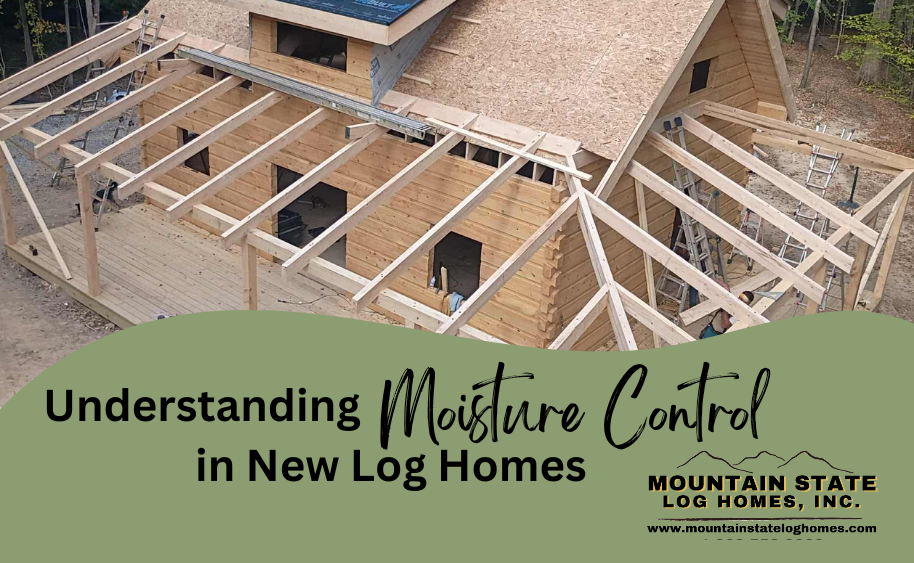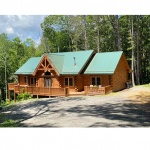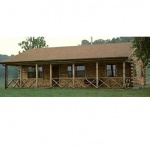

Building a log home is a dream for many — but few realize that one of the most important steps in protecting that dream begins after the walls go up.
The natural moisture inside every log continues to interact with its surroundings long after construction, influenced by humidity, heat, rain, and airflow.
Understanding how your logs dry and adjust to their environment is key to preventing mold, checking, and decay. Whether your home is built from kiln-dried white pine or air-dried hemlock, knowing how moisture content works — and how to help your home dry properly — will protect your investment for decades to come.
Our Wood Species Options
White Pine (Kiln Dried):
Our white pine logs are kiln-dried to reduce the natural moisture content of the wood before it’s ever used in your home. This controlled process creates a more stable log and reduces the amount of settling or shrinkage after construction. Even so, wood continues to “breathe” and adjust once it’s exposed to real-life environmental conditions.
Hemlock (Air Dried):
Hemlock is naturally resistant to insects and decay, so air drying is the preferred method for this species. Kiln drying can cause internal stress in hemlock, leading to surface cracks or “checking.” Air drying allows the wood to release moisture more evenly and slowly, maintaining its strength and integrity.
Why Moisture Content Matters
Every log begins its life with water inside the wood fibers and cells. Over time, that moisture needs to escape to achieve balance with the surrounding air.
If a log retains too much internal moisture when it’s sealed or enclosed, it can cause:
- Trapped moisture under stains or sealants
- Mold, mildew, or musty odors
- Uneven shrinking or swelling of logs
- Internal rot or decay over time
Proper drying allows the logs to reach equilibrium moisture content (EMC) — the point where the wood’s moisture matches the surrounding environment. This process continues even after your home is built.
Environmental Factors That Affect Moisture Content
The moisture level of your logs doesn’t stay static — it changes naturally with the weather and your home’s environment. Key factors include:
- Humidity: High humidity slows the drying process and can reintroduce moisture into the logs, especially during summer months or in damp climates.
- Rain and Snow: Exposure to rain, melting snow, or standing water around the base of the structure can increase moisture levels in logs that haven’t yet been sealed.
- Heat: Warm temperatures help accelerate drying — but excessive heat or direct sun on only one side of the home can cause uneven drying and checking.
- Seasonal Changes: Logs will expand slightly in humid summer weather and contract during the dry winter months. This is a natural “breathing” process and part of owning a real log home.
- Indoor Air Quality: Activities like cooking, showering, or running a wood stove can change interior humidity levels, affecting how quickly the logs dry inside the home.
Because every building site and season is different, there is no universal drying timeline. It’s important to monitor humidity levels during the first year and allow nature — with your help — to do its job.
After Construction: Promoting Proper Drying
Once your log home is assembled, the best thing you can do for it is encourage ventilation and consistent air movement.
We recommend:
- Running dehumidifiers
- Using ceiling fans or box fans to keep air circulating
- Opening windows when the weather allows for fresh airflow
- Avoiding early application of stains or sealants until the logs have adequately dried (especially after rainy periods)
- Keeping logs clear of vegetation and ensuring proper drainage around the foundation
These steps will help your home dry evenly and reduce the risk of moisture-related issues.
Important Homeowner Notice
Because factors such as location, weather conditions, ventilation, and building design all play a role, each home will have its own drying period.
Mountain State Log Homes provides high-quality white pine and hemlock materials in accordance with industry standards. However, natural wood movement, shrinkage, and checking are normal characteristics of solid log construction and are not considered defects.
Proper care, ventilation, and moisture management are the homeowner’s responsibility after assembly.
Our Commitment
At Mountain State Log Homes, we’re proud to offer genuine, natural log materials that are crafted with care and respect for the wood’s natural properties. With proper drying and maintenance, your home will stand strong for generations — full of warmth, character, and West Virginia charm.
Disclaimer
Mountain State Log Homes provides kiln-dried and air-dried materials designed for natural log home construction. Because wood is a living, natural material, it will continue to expand, contract, and release moisture after installation.
Mountain State Log Homes is not responsible for mold, mildew, checking, warping, or decay that occurs as a result of improper ventilation, premature sealing, lack of drying time, or environmental factors beyond our control.
It is the homeowner’s responsibility to maintain proper air circulation, moisture control, and routine maintenance to ensure the long-term performance of the log structure.
We’re Here to Help.
If you have questions about moisture content and log drying, choosing between white pine and hemlock, or preparing your new home for finishing, our team at Mountain State Log Homes would love to talk with you. We’ve helped hundreds of homeowners and builders across West Virginia and beyond understand how to care for their log homes from the start.
Give us a call at 304-884-6646 to request more information or speak with a member of our sales team today.








